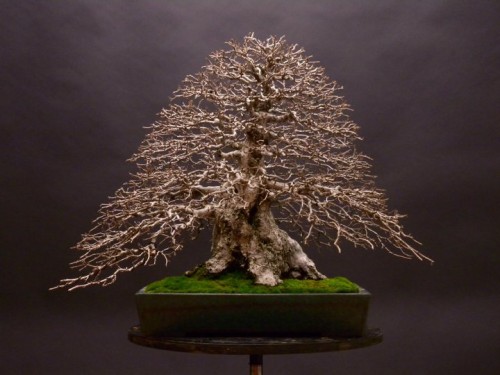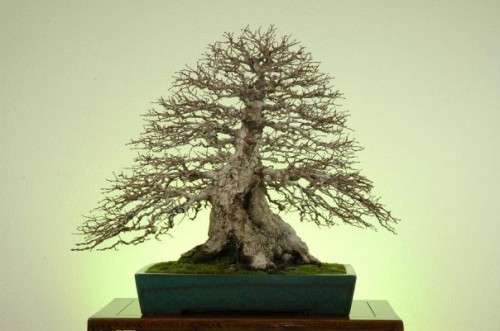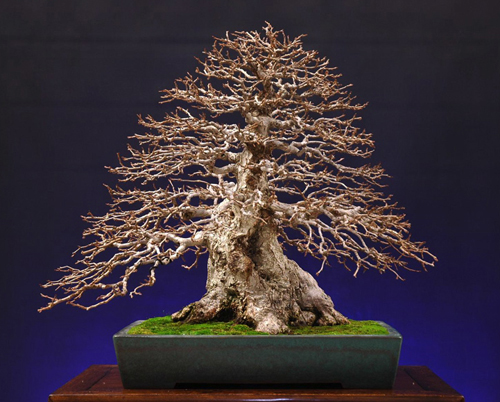
The latest incarnation of Mario Komsta’s extraordinary and now somewhat famous Hornbeam.
Balance
Is the balance better now (comparing the photo above with the earlier photo immediately below)? Does the elongated first branch (left) help to counter balance the slight rightward lean of the apex?
The base of the trunk
The base of the trunk appears stronger in the earlier photo below. Is it just the photo, or does the extended branching and the new pot diminish the power of the base?
Ramification
No matter what our thoughts about balance and the base of the trunk, the impeccable patience and masterful technique that is displayed in the ramification is undeniable. Altogether a powerful dynamic tree.

An earlier incarnation. Though the balance may not be perfect and the ramification isn’t as developed as in the top photo, I think the base of the trunk appears more powerful in this photo.
A few instructive comments
The comments that follow appeared on facebook in response to the posting of the photo immediately above. I’m not sure how much earlier this photo was taken than the photo at the top of the post.
Mauro Stemberger: very good ramification , pity the top is unbalanced, respect first branch in the left
Mario Komsta: so the apex need to following to direction of the first branch ? is this regulation? something new for me !
Mauro Stemberger: rules are made to be broken but……….this tree seems to me unbalanced …….sorry ;)
Boon Manakitivipart: Mario,very nice tree. and i agree with Mauro.

This photo, from an earlier Bonsai Bark post, appears to show the tree sometime between the two photos above.
I like the slight tension created by the apex as it is.
Hi Bruce,
In the top photo (most recent) or in the older photo that Mauro and Boon commented on? Not that there’s much difference as far as the apex goes.
I agree with Bruce; I like the tension (based on latest version). However, as I am at times a literalist in bonsai (and at times a literati ;-) I take exception to the concept of training deciduous trees (hornbeams, maples, etc.) too much like Christmas trees (although ’tis the season). Few leafy trees grow like this.
Then again, if I came across stock with a trunk and nebari like that, what would I do with it?
My only criticism is I do not like the first branch coming below the nebari-soil line. Other than that I think the top photo is a better composition than the second and intermediate third photo. Probably because of the counterbalance of the extended left first branch.
Thanks Zack. If I understand you’re saying that you don’t like the first branch, but you like it?
It is a “nice” tree but I agree with Al and deciduous trees should not look like pyramidal “Christmas trees”. Bonsai are supposed to mimic a natural mature tree in a dwarf form and hornbeams do not grow like Mario’s tree.
If the top is unbalanced it doesn’t really hurt the tree. It looks natural. Should our trees look like one off of Disney’s back lot headed for Fantasy Land ?
I would still like to have one like it and expose more interior branches.
Think about it this way;
In bonsai, we are trying to get a feeling across to those viewing our work, of an ancient tree growing out in the wild that has endured many years of harsh conditions but has been made beautiful and majestic thru the process of struggling to survive. That being said, do you think a wild tree old enough to have a trunk as massive and narley as this tree does would still be standing perfectly straight? I think the slight lean just adds a little more to this old tree’s story! Don’t worry so much about correcting such a minor flaw that you lose the character of the tree.
I was taking special note and reflecting as I was on a walk in my neighborhood (in Portland, OR) today, looking at deciduous trees. My observation is that the trees that grow from central leaders are generally poplars, alders, red oaks, acacia, sometimes liquidamber, and never pyramidal. In such a tree the upper branches reach upward. But primarily the white oaks, maples, sycamores, beeches, fruit trees, and other old venerable deciduous species have low branches that go decidedly upward and reiterate as trunks. Walter Pall gets this in his work.
As an artistic flair, I kind of enjoy the low branch on the hornbeam. I asked myself, as the branch approaches the lip of the pot, if the tree qualifies as a semi-cascade.
I like the tree in the 3rd pic with the blue background. The apex didnt bother me untill it was pointed out in the post! LOL. Dont get me wrong, I would give up alot to have a tree like that but, it is just to overly developed in the latest pic. I dont mean the ramification but you can’t apreciate the taper all the way up now (although that might be the pic angle)and the low branch is a little much for me.
I would open it up a little and go back a few nodes on the low branch. Earlier the tree had a more natural look and if you combine it with the present ramification, It would be even more awesome.
On the other hand if you did that, the tree would look more like the hundreds of other wonderful trees from Europe of this type. I do apreciate that the artist is trying to experiment and take this tree to the extreme. That is probably what sets this tree apart.
Its like show dogs. Some people like muts, Some people want purebreds, and some people like those extremely fluffy, evergroomed,little show dogs with the flowing hair and pretty bow.
Anyways, there is always room on my bench for this tree no matter how its clipped!
Hi Wayne-
I was referring to the top photo but actually it could be any one of them.
Many opinions here of how a bonsai should look. Does it need to go further than “Mario styled this tree to his liking?”
As for the maha low branch, again, it shows Mario’s fresh approach. I think it would be less interesting without it.
Hello everybody!
I am a great lover of this art … I found it very interesting all these comments. But in my opinion, I think the vessel is causing this much imbalance, because he is too rigid. For we have in him a tree with smooth moves on the trunks and branches, I believe that if we had an oval bowl with smooth motion at its edges would be more harmony in this work. Then come to relieve the Sentra attention on the apex of the taper. I come through this comment, I revere ha this beautiful work with great technique and knowledge of its artist. It’s all about my reverence for all master dexaram your comments here. I’m just a layman in love with the art of bonsai …
Carlos Adriano Silva,
Diamantina, Minas Gerais,
Brazil,
Thanks Lee,
Yes, the more I look at the latest version of this great tree, I think it is a little over styled; the shape is too symmetrical. I like the earlier (actually middle version time wise) best.
Thanks Dave,
Yes. I agree. You’d expect a tree this old show more ravages of time.
Thanks Al,
As always, your insights are appreciated. I agree about Walter Pall. Even though he never comments here (even when I discuss his trees which doesn’t happen often because he’s one of the very few who doesn’t allow reproductions – even attributed ones – from his website), still, he is one of the very best in observing and capturing the way trees grow naturally.
HI Elliot,
Yeah, I agree, the third photo is the one (it’s actually between the other two in time), and the apex didn’t bother me either, though I always pay attention to what Boon has to say. Still, you can’t deny the sill and patience that went into the final version.
I like your show dog analogy.
Hi again Bruce
“Does it need to go further than “Mario styled this tree to his liking?”
Point well taken; words surely have the power to both distract and confuse and opinions are a dime a dozen. Still, when well chosen, words can also help illuminate.
Thanks Carlos,
Aha. You are the first to mention the pot. I think we got so caught up in the tree and it’s stages of development that we overlooked the pot. You’ve got a point for sure, an oval pot might well better serve this tree.
Thanks again for your observations and for sharing your enthusiasm.